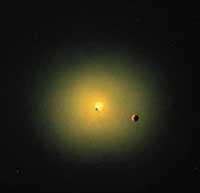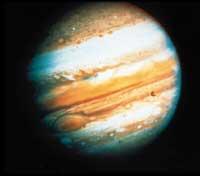Extrasolar planetary systems

Although until the time of the Renaissance the geocentric view of the universe defended by Aristotle prevailed, Epicurus, a contemporary of Aristotle, thought that the universe could be infinite, like the number of worlds similar to the Earth that could be there. Well, the problem of planets outside the solar system is not of recent years. However, it can be said that in recent years the subject has become fashionable, along with that of life off Earth.
Since the discovery of the first planet outside the Solar System was announced in October 1995, great advances have been made in this field. One of the reasons for the fashion of the subject is probably that of these advances, and that of the latter is that the current technology allows to make observations and measurements in sufficient resolution.
There are already 20 planets outside the Solar System, around 18 different stars. Until recently it was 18, each of them around a different star (see table 1), but as just pointed out, around the star Upsilon Andromedae (Ups And) there are two other planets beyond what was previously known. The news becomes especially important because from now on we can speak strictly of the planetary systems external to ours.
Given the findings that may have special consequences, scientists measure the steps very well and soon voices are heard that do not coincide with the results of the research. On this occasion it can be said that scientists have taken the discovery very well. On the one hand, because the technique used is known and contrasted; on the other, because the results are presented with the guarantee that they have been obtained by two groups of different and independent researchers.
This presentation took place at a press conference on April 15, in which both groups of researchers were represented, some from the University of San Francisco and others from the Harvard-Smithsonian Center for Astrophysics and the National Center for Atmospheric Research. In addition, G of Berkeley University. Laughlin's computer planetary system simulation suggests that it is stable.

However, we still do not know the new planetary system well. We will analyze the most significant data. As mentioned above, the star is Upsilon Andromedae, which as its name suggests is found in the constellation of Andromeda. Therefore, we can see it from next June (no optical support is necessary to be able to see it since it is a star of magnitude 4.1). It is about 44 light years from Earth and is similar to the Sun, although its mass and size are somewhat larger. Its absolute luminosity is triple that of the Sun. It is younger than our star, with 2.6 billion years of age (about half the Sun).
The data of the circling planets (Ups-And b, Ups-And c and Ups-And d) are shown in Table 2. In it it can be observed that the planets are similar in mass and size to those of Jupiter. The orbits are much smaller. Figure 1 can be seen compared to the inner planets of the Solar System.
The data mentioned in the previous two paragraphs suggest some comments. We have said that the star Ups And is similar to the Sun and the same can be said of others in Table 1. This is not representative data, but the result of a selection of stars previously made by astronomers. The discovery of planetary systems requires a long systematic observation of the star, usually annual. Therefore, before undertaking this work, the research teams make a careful selection of stars, making a list of a hundred or a few hundred. Sun-like stars have a study characteristic: The Sun has around it a series of planets, and presumably they may have other similar stars.
The second comment refers to the dimensions of the planets found. Current observation and measurement instruments and data analysis techniques do not allow smaller planets to be detected, except in exceptional cases. Of course, this does not mean that around the Ups And there is no planet of similar size to Earth. However, if there were any, their orbits would be greater than those of the three known giant planets, since even if they had arisen in their environments, the effects of their gravity would be thrown out. Therefore, they would be too far from the star, in a region too cold, to hope to create life there. Continuing with the speculative field of life outside the Earth, no alternative must be ruled out; just as Jupiter and Saturn have satellites with some similarity to Earth, also those of the Ups-And system. There may be some of these situations in a less favorable region.
In the coming years, there will be significant progress in detecting "small" planets when new telescopes are being launched on Earth, such as the four of the 8.2 metre Paranal Hill, or in orbit (Space Interferometry Mission, NASA project for 2005). The improvement of the equipment, however, will not allow to see the planets because the intensity of the light they reflect is too weak. Detection techniques are transversal. The key to the most productive, which is at the basis of the discovery of all planets in Table 1, is the Doppler effect.
Remotely we see the fixed stars in the sky, but this form of stillness hides very high speeds. If we take the Sun as an example, we must bear in mind that it runs 250 km per second. When a planet moves around the star, due to the gravitational pull of the star, the star will not have a direct path, but a kind of spiral. This fluctuation of motion we would see from Earth in the form of tremor or is very undetectable when the distance is tens of light years. For example, the observer who would see the Sun at a distance of 30 light years would see it doing a circle of one-third diameter of a million degree. It is not necessary to say that this change of position cannot be measured directly. On the contrary, if we analyze the light we receive from the star, this tremor can be calculated by measuring the Doppler effect.

The Doppler effect is a phenomenon that manifests itself in wave movements. We have all ever realized that the train, or other vehicle, when we approach the txistu, the tone of the sound is sharper than when we hear when the train moves away from us. The Doppler effect is responsible for this change of tone. In the case of light the change occurs in color. The star, by the fear of the planet, when it is making a circular tour, a half of the circumference approaches us, and then we will see the light we receive from it a little more blue. On the contrary, when you circulate through the other circumference you will move away from us and the light you receive will be redder. These small differences allow us to predict the existence or not of the planet and calculate its mass and orbit.
The discovery of the new planetary system has launched theoretical researchers. According to the explanatory models of the creation of planetary systems, the gaseous planets in the form of Jupiter or Saturn must be formed at a relatively large distance from the gaseous (at least four times the distance between the Sun and the Earth, that is, at 4 astronomical units). At this distance the temperature is relatively low so that the ice cores begin to condense and gradually the planet forms. In the Ups And system the three planets are within the mentioned limit. Were they born there? How? Perhaps they arose further outside, but later, due to the influence of gravity between them, they would change orbit and approach the star. All alternatives must be rigorously analyzed.
The current situation of this problem of planets outside Earth would not be complete if we think that those in Table 1 are all that has been found. The difference between a giant planet and a small star (a brown dwarf star) is not very clear. Normally, if the mass of the star is equal to or greater than 13 times that of Jupiter, it is assumed that the deuterium can be burned, so the planets would no longer be more than brown nanos. According to this criterion, 11 brown dwarfs have been found around so many other stars. And two planets, around the pulsar bana. On the other hand, two stars with a disc of matter are known around them, where the planets would be forming. Finally, there are 13 more cases that are in doubt or unconfirmed totally. As can be seen, we are talking about a very lively field of research and there is no doubt that in the coming years there will be many outstanding news.
Star Name | Distance to the Sun (light years) | Planet mass (MJUP=1) | Period (day) | Main semiaxis (AU) | Eccentricity | Date of |
47 Ords. | 48.28 | 2.42. | 1093 | 2.08 | 0.10 | 19/12/96 |
Dña. Upsilon | 43.94 | 0.63 | 4.621 | 0.053 | 0.03 | 11 January 2014 |
Tau Bootis | Budgets | 3.64. | 3.3126 | 0.042 | 0.00 | 25 November 1997 |
Gliese 876 | 15.33 | 2.1.- Waste management | 60.9 | 0.21 | 0.27 | 01/09/98 |
Rho Corona B. | 56.86 | 1.1. | 39.6 | 0.23 | 0.1 | February 2009 |
55 Can | 40.87 | 0.85 | 14.656 | 0.12 | 0.03 | 27/10/98 |
Gliese 86 | 35.59. | 3.6. | 15.8 | 0.11 | 0.04 | 24/11/98 |
70 Virginis | 08.59 | 7.4 | 116.7 | Total | Total | 04/12/98 |
Specifications | 132.35 | 11.0 | Library | 0.41 | 0.33 | 16/12/98 |
HD187123 | 162.85 | 0.52. | 3.097 | 0.042 | 0.00 | 17/12/98 |
Specifications | 69.45 | 1.36. | Total | 1.15. | Budget | 17/12/98 |
14 Herculis | 59.21 | Security | Values | · | 0.35 | 17/12/98 |
HD217107 | 64.33 | 1.28. | 7.11. | 0.07 | 0.14 | 11/01/99 |
HD195019 | 121.87 | 3.43. | Annex I | 0.14 | 0.05 | 11/01/99 |
HD168443 | 123.57 | 5.04 | Library | 0.28 | 0.54 | 11/01/99 |
HD75289 | 94.41 | 0.42 | 3.51 properties | 0.046 | 0.054 | 01/02/99 |
16 Cygni B | 70.53 | 1.74 | 802.8. | 1.70% | 0.68 | 15/03/99 |
51 Pegasi | Budgets | 0.44 | 4.2308 | 0.051 | 0.01 | 08/04/99 |
Name | S.P.S. | Channel | And d |
Mass (MJUP =1) | 0.71 | 2.11. | 4.61. |
Main semiaxis (AU) | 0.059 | Total | 2.50 |
Period (DAYS) | 4.6170 | 241.2 | 1266.6 |
Eccentricity | 0.034 | 0.18 | 0.41 |





